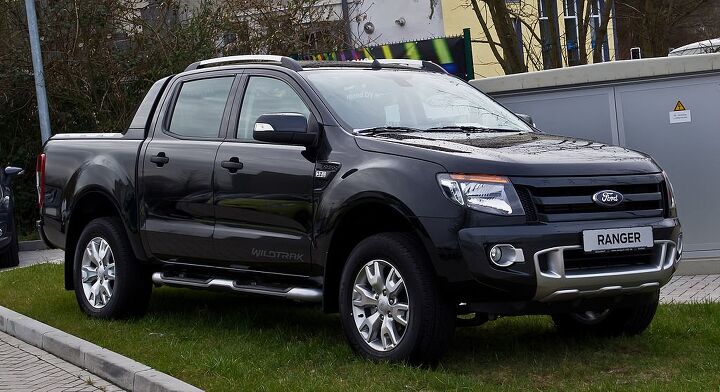Ford Mulling Smaller Pickup, But Global Ranger Is Too Big
Ford is said to be mulling a smaller pickup to slot beneath the F-150, plucked from their existing global product portfolio. One thing we are sure of is that it won’t be the new “global Ranger” sold in world markets.
Despite the relentless insistence of enthusiasts, Ford’s new Ranger will not be sold here because it is simply too big. Calling it “90% of the F-150 size”, Ford’s Dave Scott told USA Today that the new truck would be a true small truck, rather than something mid-size like the new Chevrolet Colorado.
“We’re looking at it. We think we could sell a compact truck that’s more like the size of the old Ranger, that gets six or eight more miles per gallon (than a full-size truck), is $5,000 or $6,000 less, and that we could build in the U.S. to avoid the tariff on imported trucks,” he says.
And there lies the problem. How do you find a product cheap enough to sell at such a price point (the F-150 already starts at around $20,000), and then amortize the cost of producing it in an American factory and homologating it for FMVSS standards while still making a profit? Oh, and there’s the whole CAFE thing as well.
Despite the insistence of the internet small truck brigade, the case for the small(er) truck is largely predicated on desiring variety for its own sake. The obstacles to profitability are extremely high, and there aren’t enough customers demanding a small truck to make the exercise worthwhile. The alternatives are to bring a unibody “lifestyle truck”, as Ford is exploring, or letting your current mid-sizer sit on the vine for years, sans updates, as Toyota and Nissan have done with the Tacoma and Frontier. In Nissan’s case, even developing something affordable for North American consumers on a long amortized platform was deemed to be an economically unfeasible proposition, thanks to burdensome regulations and weak demand.
The alternative is to task a risk, listen to the cheerleaders and bring out a new mid-size truck…and then have your dealers upsell potential customers into a more profitable full-size truck that also happens to have four-figure rebates attached to it. Don’t think that’s going to happen? Go ahead, I’ll wait.
More by Derek Kreindler
Latest Car Reviews
Read moreLatest Product Reviews
Read moreRecent Comments
- Ltcmgm78 It depends on whether or not the union is a help or a hindrance to the manufacturer and workers. A union isn't needed if the manufacturer takes care of its workers.
- Honda1 Unions were needed back in the early days, not needed know. There are plenty of rules and regulations and government agencies that keep companies in line. It's just a money grad and nothing more. Fain is a punk!
- 1995 SC If the necessary number of employees vote to unionize then yes, they should be unionized. That's how it works.
- Sobhuza Trooper That Dave Thomas fella sounds like the kind of twit who is oh-so-quick to tell us how easy and fun the bus is for any and all of your personal transportation needs. The time to get to and from the bus stop is never a concern. The time waiting for the bus is never a concern. The time waiting for a connection (if there is one) is never a concern. The weather is never a concern. Whatever you might be carrying or intend to purchase is never a concern. Nope, Boo Cars! Yeah Buses! Buses rule!Needless to say, these twits don't actual take the damn bus.
- MaintenanceCosts Nobody here seems to acknowledge that there are multiple use cases for cars.Some people spend all their time driving all over the country and need every mile and minute of time savings. ICE cars are better for them right now.Some people only drive locally and fly when they travel. For them, there's probably a range number that works, and they don't really need more. For the uses for which we use our EV, that would be around 150 miles. The other thing about a low range requirement is it can make 120V charging viable. If you don't drive more than an average of about 40 miles/day, you can probably get enough electrons through a wall outlet. We spent over two years charging our Bolt only through 120V, while our house was getting rebuilt, and never had an issue.Those are extremes. There are all sorts of use cases in between, which probably represent the majority of drivers. For some users, what's needed is more range. But I think for most users, what's needed is better charging. Retrofit apartment garages like Tim's with 240V outlets at every spot. Install more L3 chargers in supermarket parking lots and alongside gas stations. Make chargers that work like Tesla Superchargers as ubiquitous as gas stations, and EV charging will not be an issue for most users.































Comments
Join the conversation
I wonder how many of the former Ranger buyers' needs aren't already met between the Transit Connect and stripper F150s. I can't see a good business case to develop a whole new vehicle (platform sharing or not) for this small niche. If there really is a need for Ford to have a smaller than F-series pickup, maybe they can rebadge a Nissan Frontier/Navara (or Nissan rebadge a Ranger) to get a sufficient combined volume to warrant US federalization?
There is no way that Ford can meet the price and mileage targets, and make a profit, unless this new truck is front wheel drive and unibody. The front wheel drive unibody Transit Connect can carry over 3/4 tons of cargo, more than most 150/1500 series trucks, so a serious truck can be made on that kind of platform. Talk of using an existing platform that is not the global Ranger makes it fairly clear Ford is thinking of a FWD unibody platform.